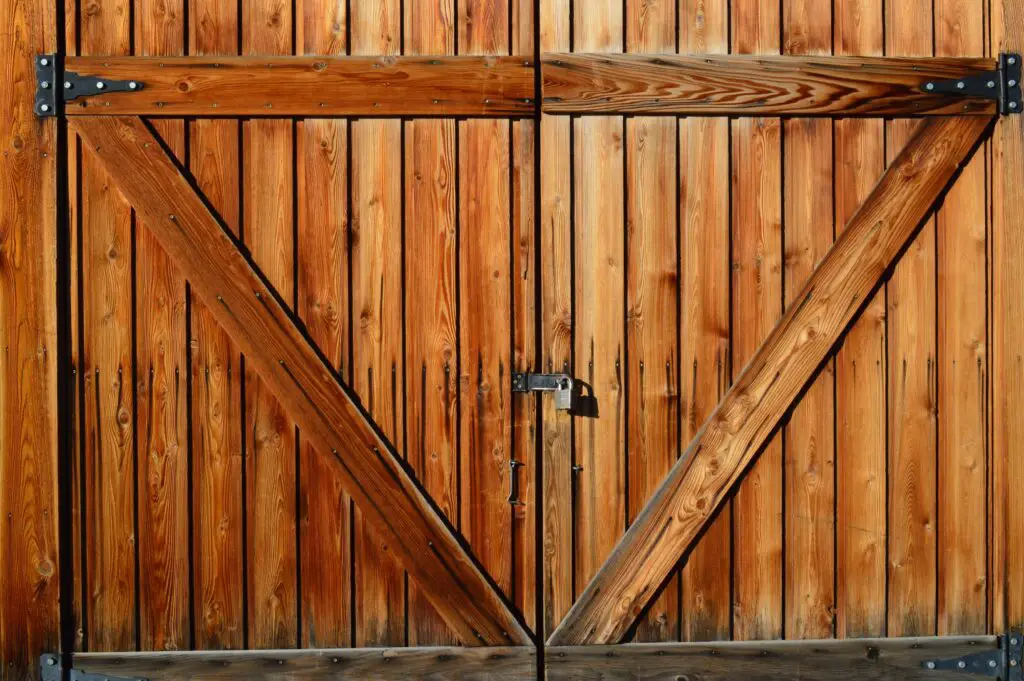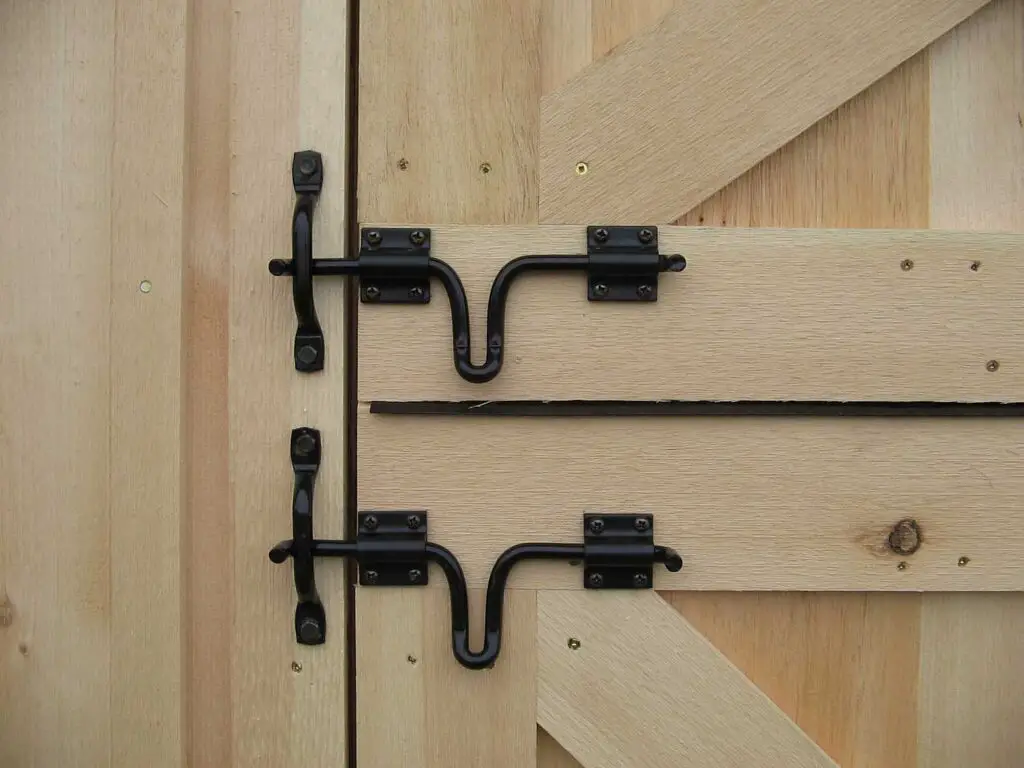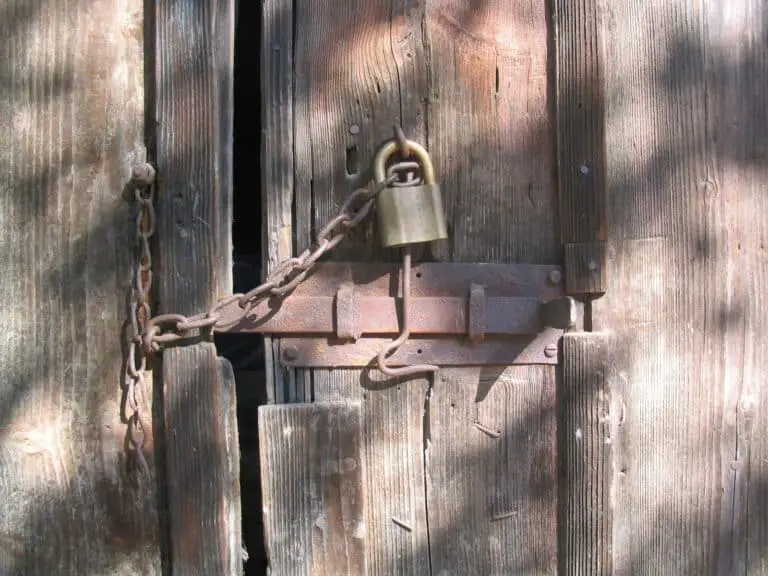Introduction
How To Lock A Barn Door: Locking a barn door is an essential task for any barn owner or caretaker. Barns are often used to store valuable equipment, livestock, and other important items, making it crucial to ensure their security. A properly locked barn door not only protects your belongings from theft but also helps to keep animals safe and secure. In this article, we will discuss various methods and techniques to effectively lock a barn door.
Before delving into the different ways to lock a barn door lock, it is important to understand why barn door security is crucial. Barns are often located in rural areas, making them vulnerable to theft and trespassing. Additionally, barns house valuable equipment such as tractors, tools, and machinery, which are attractive targets for thieves. Moreover, barns are home to livestock, and a secure barn door ensures that animals cannot escape or be harmed by intruders.
Overall, there are several ways to lock a barn door, ranging from simple padlocks to more advanced electronic keypad locks. The best method for securing a barn door will depend on factors such as the size and weight of the door, the level of security required, and personal preference. By choosing the right lock and taking appropriate security measures, barn owners can ensure that their doors are effectively locked and their property is protected.

Is there a way to lock a barn door?
Yes, there are several ways to lock a barn door. Barn doors are typically large and heavy, making them difficult to secure with traditional locks. However, there are specialized locks and techniques that can be used to effectively secure a barn door and prevent unauthorized access.
One common method of locking a barn door is to use a padlock and hasp. A hasp is a metal plate that is attached to the door frame, and a padlock is then used to secure the door to the hasp. This provides a simple and effective way to lock the door, as the padlock is difficult to remove without the key. Additionally, there are heavy-duty padlocks available that are specifically designed for use on barn doors, providing added security.
Another option for locking a barn door is to use a sliding bolt lock. This type of lock is installed on the inside of the door and consists of a metal bolt that slides into a metal bracket attached to the door frame. When the bolt is in the locked position, it prevents the door from being opened. Sliding bolt locks are often used in conjunction with other locks, such as padlocks, to provide multiple layers of security.
In addition to these traditional lock options, there are also more advanced locking systems available for barn doors. For example, some barn doors can be equipped with electronic keypad locks. These locks require a code to be entered in order to unlock the door, providing a convenient and secure way to control access to the barn. Some electronic keypad locks also have the ability to track who has entered the barn and at what time, providing an added level of security and accountability.
Can you lock a sliding door?
Yes, it is possible to lock a sliding door. Sliding doors are a popular choice for many homeowners due to their sleek design and ability to let in natural light. However, some people may have concerns about the security of sliding doors and whether they can be locked effectively.
The answer to this question is yes, sliding doors can be locked. In fact, most sliding doors come with a built-in locking mechanism that allows you to secure the door in place. This locking mechanism is typically located on the edge of the door and can be engaged by simply turning a knob or lever.
There are several types of locks that can be used to secure a sliding door. One common type is a pin lock, which is a small metal rod that can be inserted into a hole in the door frame to prevent the door from sliding open. Another type of lock is a key lock, which requires a key to engage and disengage the locking mechanism.
It is important to note that while sliding doors can be locked, they may not provide the same level of security as other types of doors. Sliding doors are often made of glass, which can be more easily broken than solid wood or metal doors. Additionally, the locking mechanisms on sliding doors may not be as strong or secure as those on other types of doors.
However, there are steps you can take to improve the security of your sliding door. One option is to install a security bar or rod that can be placed in the track of the door to prevent it from being forced open. Another option is to install a security film on the glass of the door, which can make it more difficult to break.
Do barn doors need blocking?
When it comes to installing barn doors, one common question that arises is whether or not they need blocking. Blocking refers to the process of adding additional support or reinforcement to the wall where the barn door will be installed. This is done to ensure that the door is securely attached and can withstand the weight and movement without causing any damage to the wall or the door itself.
In most cases, barn doors do require blocking. This is especially true if the door is being installed on a wall that is not made of solid wood or if the wall is not structurally sound. Blocking helps to distribute the weight of the door evenly across the wall, preventing any sagging or warping over time. It also provides a solid anchor point for the door hardware, ensuring that it remains securely in place.
There are a few different methods for blocking a wall for a barn door. One common approach is to use a piece of plywood or a 2×4 board that is cut to fit snugly between the wall studs. This piece of blocking is then attached to the studs using screws or nails. Another option is to use metal brackets or braces that are specifically designed for this purpose. These brackets can be attached to the studs and provide additional support for the door.
It is important to note that the specific requirements for blocking may vary depending on the weight and size of the barn door, as well as the type of wall it is being installed on. It is always recommended to consult the manufacturer’s instructions or seek professional advice to ensure that the blocking is done correctly and meets the necessary safety standards.
All barn doors may require blocking, it is generally recommended to add this additional support to ensure the door’s stability and longevity. Blocking helps to distribute the weight of the door and provides a secure anchor point for the hardware. By following the appropriate blocking methods and guidelines, you can ensure that your barn door is installed safely and securely.
What disadvantage can you see in a barn door?
A barn door is a type of sliding door that is commonly used in barns and other agricultural buildings. It is a popular choice for its rustic and charming aesthetic, as well as its functionality. However, like any other type of door, barn doors also have their disadvantages.
One disadvantage of a barn door is its limited privacy. Unlike traditional doors that fit snugly into a door frame, barn doors slide along a track and do not completely seal off a room. This means that there may be gaps between the door and the wall, allowing sound and light to pass through. This lack of privacy can be a concern in certain situations, such as in bedrooms or bathrooms.
Another disadvantage of a barn door is its potential for noise. Since barn doors slide along a track, they can create a loud noise when opened or closed. This can be disruptive, especially in quiet environments or during nighttime when others may be sleeping. Additionally, the noise can be a nuisance if the door is frequently used, as it can become irritating over time.
Furthermore, barn doors may not be suitable for all types of spaces. Due to their sliding mechanism, barn doors require wall space on either side of the opening to accommodate the door when it is fully open. This means that they may not be suitable for smaller rooms or spaces with limited wall space. In such cases, a traditional hinged door may be a more practical option.
Lastly, barn doors can be more expensive than traditional doors. The hardware required for a barn door, such as the track, rollers, and handles, can be costly. Additionally, the installation process may require professional assistance, further adding to the overall cost. Therefore, budget-conscious individuals may find that a barn door is not the most cost-effective choice for their needs.
Does barn door touch the floor?
Yes, a barn door can touch the floor. In fact, it is quite common for barn doors to touch the floor when they are closed. This is because barn doors are designed to provide a tight seal and prevent any drafts or pests from entering the barn. By touching the floor, the door creates a barrier that helps to keep the interior of the barn secure and protected.
When a barn door is closed, it typically hangs from a track system that is mounted above the doorway. This allows the door to slide open and closed smoothly. The bottom of the door is usually equipped with a guide or a floor guide that helps to keep the door aligned and prevents it from swinging or swinging open. This guide also helps to ensure that the door touches the floor when it is closed.
There are several benefits to having a barn door that touches the floor. One of the main advantages is that it helps to keep the interior of the barn clean and free from debris. When the door touches the floor, it creates a barrier that prevents dirt, dust, and other particles from entering the barn. This can be especially important for farmers who store valuable equipment or livestock inside their barns.
In addition to keeping the interior clean, a barn door that touches the floor also helps to provide insulation. By creating a tight seal, the door helps to keep the cold air out in the winter and the hot air out in the summer. This can help to regulate the temperature inside the barn and make it more comfortable for both humans and animals.
Abarn door can touch the floor when it is closed. This is a common design feature that helps to provide a tight seal, keep the interior clean, and provide insulation. Whether you are a farmer or simply someone who appreciates the rustic charm of a barn door, knowing that it touches the floor can help you make an informed decision when choosing a door for your barn or home.
When it comes to securing a barn door, there are several types of locks that can be used. One common option is a padlock, which can be attached to a hasp or latch on the door. Padlocks come in various sizes and strengths, so it’s important to choose one that is suitable for the level of security needed.
Another type of lock that can be used is a deadbolt lock. Deadbolts are known for their strength and durability, making them a popular choice for securing barn doors. They are typically installed on the inside of the door and require a key to lock and unlock.
In addition to padlocks and deadbolts, there are also sliding door locks that can be used on barn doors. These locks are specifically designed for sliding doors and provide an extra layer of security. They are often installed on the top or bottom of the door and can be locked with a key or a latch.
Are there any specific security measures that should be taken when locking a barn door?
When it comes to securing a barn door, there are several specific security measures that should be taken to ensure maximum protection. Firstly, it is important to choose the right type of lock for your barn door. There are various options available, such as padlocks, deadbolts, and sliding door locks. Each type has its own advantages and disadvantages, so it is crucial to select one that suits your specific needs and provides the highest level of security.
Additionally, it is recommended to install a reinforced strike plate on the door frame. This will help prevent forced entry by making it more difficult for intruders to kick or pry open the door. It is also advisable to use long screws when attaching the strike plate and hinges, as this will further enhance the door’s resistance to forced entry.
How can one ensure that a barn door is securely locked to prevent unauthorized access?
Ensuring that a barn door is securely locked is crucial to prevent unauthorized access and protect the contents of the barn. There are several steps that can be taken to achieve this.
Firstly, it is important to choose the right type of lock for the barn door. There are different types of locks that can be used, such as padlocks, deadbolts, and sliding door locks. Each type has its own advantages and disadvantages, so it is important to consider the specific needs and requirements of the barn.
Secondly, proper installation of the lock is essential. The lock should be securely attached to the door and the door frame to ensure that it cannot be easily tampered with or removed. It is also important to regularly inspect the lock for any signs of wear or damage, and replace it if necessary.

Conclusion
Locking a barn door is an essential step in ensuring the safety and security of the contents inside. Whether you are a farmer looking to protect your livestock or a homeowner wanting to secure your storage space, knowing how to properly lock a barn door is crucial. By following a few simple steps and using the right tools, you can effectively secure your barn door and have peace of mind knowing that your belongings are safe.
The first step in locking a barn door is to assess the type of door and the locking mechanism it has. Barn doors can come in various styles, such as sliding doors, hinged doors, or Dutch doors. Each type may require a different approach to locking. For sliding doors, a latch or bolt system can be used to secure the door in place. Hinged doors may require a traditional lock and key mechanism, while Dutch doors often have a latch or chain system to keep the top and bottom halves secured.
Once you have determined the type of door and locking mechanism, the next step is to ensure that the door and frame are properly aligned. A misaligned door can make it difficult to lock and may compromise the security of the door. Check for any gaps or misalignments and make the necessary adjustments to ensure a snug fit. This will also prevent any drafts or pests from entering the barn.
Finally, choose a high-quality lock that is suitable for the size and weight of your barn door. There are various types of locks available, such as padlocks, deadbolts, or combination locks. Consider the level of security you require and choose a lock that meets your needs. Additionally, regularly inspect and maintain the lock to ensure it is functioning properly and replace it if necessary.

